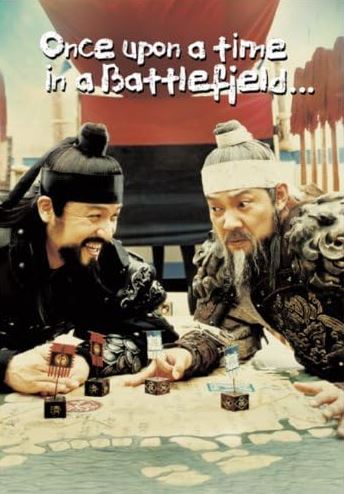In the South Korean historical comedy film Once Upon a Time in a Battlefield, Hwangsanbeol (2003), all the characters speak in regional dialects. There is a scene before the Battle of Hwangsanbeol where Prince Kim Beopmin of Silla and General Kim Yushin have a heated debate. During this exchange, Kim Yushin delivers a striking line to Prince Kim Beopmin:
“You and your father may know politics, but you know nothing about war. In this world, it’s not the strong who survive, but those who survive who are strong!”
Darwin’s theory of evolution can be summarized as the idea that those with traits favorable to their environment survive, while those without such traits perish. This principle of “survival of the fittest” is often applied to human society. The “fittest” refers to those who are well-suited to their environment. If we consider those who adapt well to their environment as the strong, then it is indeed the strong who survive. However, in the movie, Kim Yushin argues that it is not the strong who survive, but rather those who survive are considered strong. It’s hard not to nod in agreement. Whether through competitiveness or sheer luck, those who adapt to their environment and survive could indeed be called strong. Yet, the essence of evolution lies not in the survivor but in the traits that aid survival. It is not the individual with advantageous traits who survives, but rather the advantageous traits, or “characteristics,” that persist.
When discussing complex systems, we chose “network” as a key term. Both natural and social networks have the characteristic of self-organizing, evolving, and disappearing over time. How can we explain such changes? If there is one keyword that can explain these changes well, it would be the word “evolution.” Without any directive or plan, these networks adapt and function efficiently on their own. Eric Beinhocker emphasizes that “organizations, markets, and economies are not merely similar to ecosystems; they are literally evolving systems.” According to the theory of evolution, today’s intricate and complex organisms evolved from single-celled organisms over billions of years. Eric Beinhocker interprets our economy as having increased in diversity and complexity through the constant repetition of variation, selection, and diffusion—basic principles of evolution—as it adapted to its environment. The development of today’s economy, from a hunting-and-gathering economy using a few simple tools to an economy that produces and distributes billions of diverse and complex products, is indeed analogous to the evolution of ecosystems.
While it’s uncertain whether humans evolved from single-celled organisms like amoebas, it is clear that all living organisms select traits that are more advantageous for their reproduction and survival. If living organisms lacked the ability to actively choose, we can understand that survival traits were selected by nature. In any case, traits advantageous to the environment were likely continuously strengthened and replicated through this process. Humans, compared to other living organisms, have the ability to more actively select advantageous traits. This ability to differentiate is what sets us apart. In other living creatures, differentiation appears through variation. However, humans actively attempt differentiation to gain a competitive edge, creating new innovations. If successful, people will replicate or modify these innovations to suit their needs, creating further differentiation. Through this process of “copying,” people develop their unique characteristics. Successful differentiation becomes a model for others, leading to widespread adoption. Thus, the concepts of variation, selection, and diffusion in ecosystems correspond to the active differentiation, selection, and replication in human society. The term “evolution,” when applied specifically to human society, can be understood as a kind of “learning algorithm” for accumulating knowledge. As Eric Beinhocker puts it, evolution is “trying many things, seeing the results, doing more of what works and less of what doesn’t.” In our society, we constantly test various technologies and designs, observe how they work, and adopt what succeeds while discarding what doesn’t. Consequently, technologies or businesses that are adopted survive, and if they succeed, they are replicated.
As mentioned, evolutionary economists view the economy as an order in which three domains—”physical technologies,” “social technologies,” and “business plans”—individually evolve while co-evolving simultaneously. The process of developing from a wheel made of stone to cars, airplanes, and spacecraft is the evolution of physical technology, a domain primarily explored by natural sciences. The evolution of social technology can be seen in the progression from small family-based groups for hunting and farming to the emergence of markets, the invention of money and double-entry bookkeeping, the development of corporations, and the formation of capital markets—this belongs to the realm of social sciences. In economic terms, the fundamental element of biological evolution, the gene, corresponds to the “business plan” as a collection of knowledge. In this sense, a business plan can be described as a collection of knowledge or comprehensive wisdom for survival, especially in its ability to integrate physical and social technologies. In reality, resources are invested in selected business plans to test their viability. Successful business plans, once tested, are spread through other companies, the media, and scholars, leading to numerous imitators. This is the evolutionary mechanism of the economy as defined by Eric Beinhocker. This process must be continually repeated, as survival depends on creating new differentiation. Without new attempts, species become extinct, and companies disappear—this is why the corporate ecosystem is constantly changing, just like the natural ecosystem.
Hegel explained the laws of historical development with the theory of thesis, antithesis, and synthesis. He referred to the existing as the thesis, the new or external as the antithesis, and the result of their interaction as the synthesis. The term “fusion” today also refers to the combination of different cultures; while the word is new, the phenomenon has existed since the past. The advancement of culture and humanity has ultimately progressed through continuous fusion. The process of thesis, antithesis, and synthesis doesn’t apply only to social change—it’s also true in science and technology. No technology develops independently; all technologies depend on their relationships with other technologies. For example, while the invention of the mobile phone utilized radio technology, it ultimately required the help of other fields like computer technology and coding. Social technologies and knowledge have also evolved through mutual influence and will continue to do so.
Genrich Altshuller, who developed the TRIZ methodology for creative problem-solving, summarized three important discoveries while analyzing global patents. First, problems and their solutions recur across industries and scientific fields. Second, the patterns of technological evolution also recur across industries and scientific fields. Third, innovation in one field occurs by utilizing the science of another. To summarize Altshuller’s findings, technology is not invented but evolves through imitation. Complexity economists agree that physical and social technologies are advancing through an evolutionary algorithm. Children create their own inventions using LEGO blocks. We, too, have taken knowledge, physical, and social technologies, broken them down into pieces, and reassembled them like LEGO blocks to create new inventions. Of course, outstanding individuals have discovered new types of LEGO blocks, and the variety of inventions we can create with these new blocks has increased. LEGO, founded by a Danish carpenter in 1932, is an abbreviation of “Leg godt,” meaning “play well.” According to the company, two LEGO blocks can create 24 different forms, and six blocks can combine into 915 million configurations, ensuring endless play possibilities. This is possible because all LEGO blocks are standardized. Though they differ in shape, size, and color, any block can fit with any other, providing limitless assembly possibilities.
These LEGO blocks are essentially the same as the “modules” that adults use. The concept of a module is not particularly new; it’s simply a component, albeit one that is interchangeable, standardized, and defined by specific criteria. The result is that modules are characterized by both scalability and modifiability. Modules can be combined in different ways to create new or modified products, or combined with modules from other products to create entirely new ones. When machines or computer programs are modularized, cost and time are saved, which is why modularization is common across industries. However, more importantly, if knowledge or technologies are modularized conceptually, evolution and advancement can be accelerated. Frequently used modules correspond to the favorable traits or characteristics described in evolutionary theory. The advantage of knowledge and technology is that, being abstract, they can easily be modularized according to the user’s needs.
As Kim Clark of Harvard Business School pointed out, technology is essentially modular. In his book The Fourth Discontinuity: The Co-Evolution of Humans and Machines, Bruce Mazlish emphasizes that the concept of “evolution” applies not only to humans but also to machines. The fundamental unit of evolution he discusses is also the module. Knowledge can be fundamentally understood as various modules. Consulting firms, business school professors, and entrepreneurs all focus on finding and spreading best practices, which Eric Beinhocker identifies as modules. Beinhocker refers to the glue connecting these modules as strategy. Therefore, business plans must include these strategies.
Thomas Edison once said, “Your ideas only need to be original in the sense that no one else is applying them to the problem you’re working on.” This suggests that not everything needs to be original, nor does it need to be. It’s enough to start with imitation and then add a creative touch to just one part. Viewing knowledge as composed of modules, if you take modules developed by others and combine them, you create a new invention. Adding a module you’ve developed yourself enhances the originality and value. For example, the Korean auction site Auction (www.auction.co.kr) originally imitated eBay, the company that eventually acquired it. eBay had the module of internet auctions, and Auction developed a buyer protection program module to integrate with it, resulting in another creation. We can find numerous examples of such evolutionary technology. Digital technology combined with existing electronic products led to the creation of digital electronics. PDPs and DVDs are examples. The convergence of electronic technology and biotechnology is giving rise to biochips. Of course, such products are accelerated by new modules created by information technology (IT), biotechnology (BT), and nanotechnology (NT), which involves creating and manipulating objects at the nanometer scale.
We all learn and master these modules through experience and learning. How and where to use these modules is up to the individual. This is why most knowledge can become wisdom depending on its application. Creating something unique is a process of integrating or recombining the knowledge one has, but it also involves following others and adding one’s imagination. Learning is essentially about following, and adding even a small amount of one’s imagination while following others’ achievements or methods is what research in academia and creativity in the arts are about. The playwright Oscar Wilde emphasized that imagination itself is about imitation and that it is the absolute spirit necessary for creation.
“Creative thinking is not a talent. It is a skill that can be learned.” ~ Edward de Bono


답글 남기기